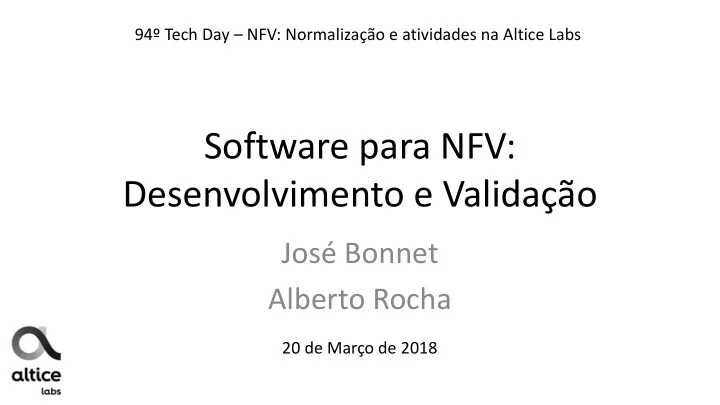

94º Tech Day – NFV: Normalização e atividades na Altice Labs Software para NFV: Desenvolvimento e Validação José Bonnet Alberto Rocha 20 de Março de 2018
July 2015 July 2016 July 2017 December 2017
Core Objectives • Reduce time-to-market of networked services: SONATA offers a valuable NFV- enabled SDK for service developers to easily create and deploy networked services on top of telecom operators’ resources. It also promotes a DevOps model to integrate service development and management operations of virtual network functions . • Optimize resources utilization and reduce costs of service deployment and operation: SONATA Service Platform orchestrates and maps complex services to connectivity, computing and storage resources and automatically re-configures running services. Network service management is done via programmable FSM/SSM plug-ins to flexibly change the behavior of network services. • Accelerate industry adoption of software networks: SONATA supports the full lifecycle of a service and allows NFV integration and interoperability with already existing network management systems.
Key Contributions SONATA offers an integrated NFV Service platform that includes both : • A novel Network Service Development Kit (SDK) that provides a valuable set of tools that assists developers in the development and testing of complex NFV services. A highly modular and customizable Service Platform with a MANO orchestrator for • deployment and management of complex network services over multiple PoPs. SONATA also implements a extended DevOps model with a multi-organisational design that increases efficiency and collaboration, facilitates the launch of new services and accelerates the adoption of NFV technologies.
SONATA Architecture: a high-level look
SONATA Architecture: a high-level look Innovations • Modular plug-in architecture: third-party SONATA SDK SONATA Service Platform logic support for operator and service developers (FSM/SSM) Platform Debugging & • Interoperable and Vendor agnostic: Catalogues Testing Tools support for multiple VIMs, VNFs, Extended MANO Packaging Tool underlying ETSI-based architecture Repositories Framework • Built for NFV DevOps between operator and service developers of network Private Catalogues Gatekeeper services • “Recursion” support : allowing stacked VIM / WIM tenant and wholesale deployments in Public Catalogues NF NF software networks models (e.g. MVNO) Infrastructure NF SONATA is an open source project published in a public GitHub repository under Apache v2.0 licence. Current code release and related technical documentation is available on the project website: www.sonata-nfv.eu
SONATA 3.1 – March 2018 • Upgraded release which includes all the software components developed, integrated, tested and qualified within the time horizon of the project. • Main improvements: New features (e.g. multi-PoP support) that makes SONATA more attractive with a product-like code that can be easily adopted. Additional interfaces for ensuring interoperability with OSS and SLA management systems and other building blocks and components such as self- monitoring facilities allowing critical operational information to be shared with the platform owner. Lower usage entry-barrier, thanks to its easy and automated installation process, compelling and complete documentation tutorial videos provided. Higher reliability and stability, due to the final stage of validation and qualification included in the SONATA development pipeline. Many SDK tools extended to interoperate with other platforms beyond 7 SONATA scope, for example OSM.
Learn more about SONATA • Project website: http://www.sonata-nfv.eu/ • Twitter: https://twitter.com/sonataNFV • LinkedIn: www.linkedin.com/in/sonata-nfv • YouTube: https://www.youtube.com/channel/UC_vQQq7mjvHt4JzEkp4kppQ • ResearchGate: https://www.researchgate.net/project/H2020-SONATA • You can also subscribe to our newsletter here: http://www.sonata- nfv.eu/newsletter/30 8
June 2017 June 2018 June 2019 November 2019s
5GTANGO Objectives Reduce the time-to-market for Reduce the entry barrier to 3rd party networked services by shortening developers and support the creation the service development cycle and and composition of Virtual Network by qualifying those network services Functions (VNFs) and application to be adopted. elements as "Network Services". Enable new business opportunities Accelerate the NFV uptake in with the customisation and industry via an 'extended' DevOps adaptation of the network to vertical model and the validation at scale of application´s requirements. Network Service capabilities of the 5GTANGO platform in vertical show cases.
5GTANGO: value for stakeholders Service Platform with 5GTANGO's SDK Validation & Verification Store DevOps Tools / Methodology Orchestrator network operators service providers, network operators, service telecom sector equipment vendors, providers, equipment SME developers vendors, SME developers • efficiency on network • lower the barrier to • open environment for • time-to-market reduction, infrastructure entry the Telecom innovation increased productivity • higher service levels sector • increase of service • create ecosystem leading to • dynamic network • differentiation in lifecycle automation differentiation and increased scalability changing market • guarantee of carrier revenue • simplify network grade requirements • lower barrier to entry, new management • lower the barrier to entry business models, closer B2B • lower OpEx, CapEx the Telecom sector collaboration • vendor lock-in • new business alleviation opportunities
5GTANGO Testbeds
5GTANGO Aveiro Testbed • 3 Dell RX730 bare metal servers and one Pica8 P-3297 SDN switch: – Dell RX730 servers: • CPU: Intel(R) Xeon(R) CPU E5-2640 v4 @ 2.40GHz • RAM: 4*32 GB DDR4 (total memory: 128 GB) • DSK: 3,75 TB of Available RAID Disk Space • NET: Intel(R) 10G 2P X520 Adapter + Intel(R) 2P X540/2P I350 rNDC • 3 nodes with dual socket of 10 cores per node + conservative over provisioning ratio of 10: – able to instantiate near 600 'm1.small' flavor VM's while there is enough memory; – considering the limit of 384 GB of RAM, we can host up to 192 VMs simultaneously;
5GTANGO Aveiro testbed topology
Obrigado! Perguntas? jbonnet@alticelabs.com alberto-m-rocha@alticelabs.com
Recommend
More recommend